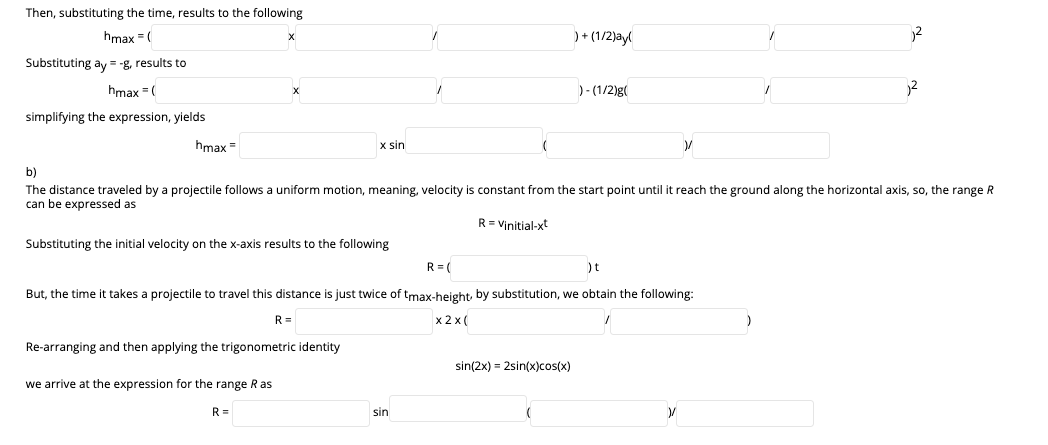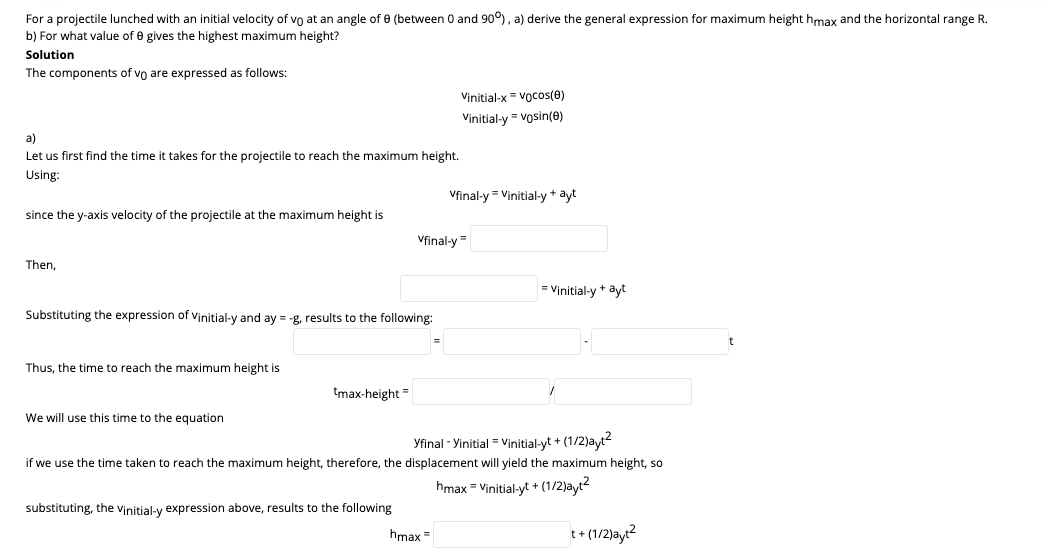For a projectile lunched with an initial velocity of vo at an angle of e (between 0 and 90°), a) derive the general expression for maximum height hmax and the horizontal range R. b) For what value of e gives the highest maximum height?
For a projectile lunched with an initial velocity of vo at an angle of e (between 0 and 90°), a) derive the general expression for maximum height hmax and the horizontal range R. b) For what value of e gives the highest maximum height?
College Physics
11th Edition
ISBN:9781305952300
Author:Raymond A. Serway, Chris Vuille
Publisher:Raymond A. Serway, Chris Vuille
Chapter1: Units, Trigonometry. And Vectors
Section: Chapter Questions
Problem 1CQ: Estimate the order of magnitude of the length, in meters, of each of the following; (a) a mouse, (b)...
Related questions
Concept explainers
Topic Video
Question

Transcribed Image Text:Then, substituting the time, results to the following
hmax = (
)+ (1/2)ayl
2
Substituting ay = -g, results to
hmax =(
)- (1/2)g(
simplifying the expression, yields
hmax =
x sin
b)
The distance traveled by a projectile follows a uniform motion, meaning, velocity is constant from the start point until it reach the ground along the horizontal axis, so, the range R
can be expressed as
R= Vinitial-xt
Substituting the initial velocity on the x-axis results to the following
R = (
)t
But, the time it takes a projectile to travel this distance is just twice of tmax-height by substitution, we obtain the following:
R =
x 2 x (
Re-arranging and then applying the trigonometric identity
sin(2x) = 2sin(x)cos(x)
we arrive at the expression for the range Ras
R=
sin

Transcribed Image Text:For a projectile lunched with an initial velocity of vo at an angle of 0 (between 0 and 90°), a) derive the general expression for maximum height hmax and the horizontal range R.
b) For what value of 0 gives the highest maximum height?
Solution
The components of vo are expressed as follows:
Vinitial-x = Vocos(e)
Vinitial-y = vosin(e)
a)
Let us first find the time it takes for the projectile to reach the maximum height.
Using:
Vfinal-y = Vinitial-y * ayt
since the y-axis velocity of the projectile at the maximum height is
Vfinal-y=
Then,
= Vinitial-y + ayt
Substituting the expression of Vịnitial-y and ay = -g, results to the following:
Thus, the time to reach the maximum height is
tmax-height=
We will use this time to the equation
Yfinal - Yinitial = Vinitial-yt + (1/2)ayt2
if we use the time
reach the maximum height, therefore, the displacement will yield the
hum height, so
hmax = Vinitial-yt + (1/2)ayt2
substituting, the vinitial-y expression above, results to the following
hmax =
t+ (1/2)ayt?
Expert Solution
This question has been solved!
Explore an expertly crafted, step-by-step solution for a thorough understanding of key concepts.
Step by step
Solved in 2 steps

Knowledge Booster
Learn more about
Need a deep-dive on the concept behind this application? Look no further. Learn more about this topic, physics and related others by exploring similar questions and additional content below.Recommended textbooks for you

College Physics
Physics
ISBN:
9781305952300
Author:
Raymond A. Serway, Chris Vuille
Publisher:
Cengage Learning

University Physics (14th Edition)
Physics
ISBN:
9780133969290
Author:
Hugh D. Young, Roger A. Freedman
Publisher:
PEARSON

Introduction To Quantum Mechanics
Physics
ISBN:
9781107189638
Author:
Griffiths, David J., Schroeter, Darrell F.
Publisher:
Cambridge University Press

College Physics
Physics
ISBN:
9781305952300
Author:
Raymond A. Serway, Chris Vuille
Publisher:
Cengage Learning

University Physics (14th Edition)
Physics
ISBN:
9780133969290
Author:
Hugh D. Young, Roger A. Freedman
Publisher:
PEARSON

Introduction To Quantum Mechanics
Physics
ISBN:
9781107189638
Author:
Griffiths, David J., Schroeter, Darrell F.
Publisher:
Cambridge University Press

Physics for Scientists and Engineers
Physics
ISBN:
9781337553278
Author:
Raymond A. Serway, John W. Jewett
Publisher:
Cengage Learning

Lecture- Tutorials for Introductory Astronomy
Physics
ISBN:
9780321820464
Author:
Edward E. Prather, Tim P. Slater, Jeff P. Adams, Gina Brissenden
Publisher:
Addison-Wesley

College Physics: A Strategic Approach (4th Editio…
Physics
ISBN:
9780134609034
Author:
Randall D. Knight (Professor Emeritus), Brian Jones, Stuart Field
Publisher:
PEARSON